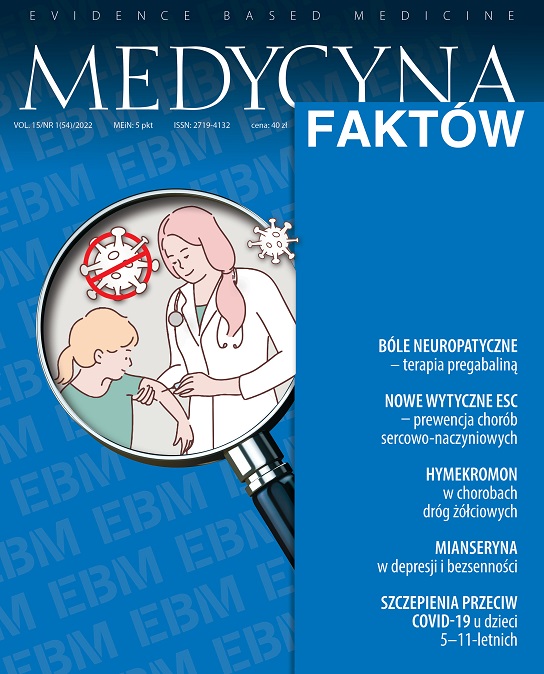Hymecromone in the therapy of bile tract disorders and its new therapeutic perspectives – a literature review Review article
Main Article Content
Abstract
Hymecromone (4-methylumbelliferone; 7-hydroxy-4-methylcumarine) is a well-known drug effective in biliary tract disorders with a very favorable safety profile, which makes it readily used by doctors and patients. The medication has a unique three-phase mechanism of action which includes: choleretic – enhances the secretion of low-density bile; cholekinetic – stimulates the flow and excretion of bile to the intestines, and spasmolytic activity – reduces the tension of smooth muscles of the bile ducts as well as Oddi’s sphincter. In recent years, there have been reports on new features of hymecromone, which arouse great interest in the context of its potential use in other than currently recommended indications, including neoplastic, inflammatory, and autoimmune diseases. In this article, we discuss common and new mechanisms of hymecromone action, with particular emphasis on its role in biliary dyskinesia.
Article Details
Copyright © by Medical Education. All rights reserved.
References
2. Sobol E, Muszyński J. Biliary dyskinesia. Przewodnik Lekarza/Guide for GPs. 2005; 8(3): 98-106.
3. Hundt M, Basit H, John S. Physiology, Bile Secretion. 2021 Oct 1. In: StatPearls [Internet]. Treasure Island (FL): StatPearls Publishing; 2021.
4. Boyer JL. Bile formation and secretion. Compr Physiol. 2013; 3(3): 1035-78. http://doi.org/10.1002/cphy.c120027.
5. National Center for Biotechnology Information. PubChem Compound Summary for CID 5280567, Hymecromone (access: 11.01.2022).
6. CHARAKTERYSTYKA PRODUKTU LECZNICZEGO. Cholestil Max (access: 16.01.2022).
7. Nagy N, Kuipers HF, Frymoyer AR et al. 4-methylumbelliferone treatment and hyaluronan inhibition as a therapeutic strategy in inflammation, autoimmunity, and cancer. Front Immunol. 2015; 6: 123. http://doi.org/10.3389/fimmu.2015.00123.
8. Abate A, Dimartino V, Spina P et al. Hymecromone in the treatment of motor disorders of the bile ducts: a multicenter, double-blind, placebo-controlled clinical study. Drugs Exp Clin Res. 2001; 27: 223-31.
9. Krawzak HW, Heistermann HP, Andrejewski K et al. Postprandial bile-duct kinetics under the influence of 4-methylumbelliferone (hymecromone). Int J Clin Pharmacol Ther. 1994; 33: 569-72.
10. Trabucchi E, Baratti C, Centemero A et al. Controlled study of the effects of tiropramide on biliary dyskinesia. Pharmatherapeutica. 1986; 4: 541-50.
11. NFZ. Polipragmazja, czyli wielolekowość w praktyce (access: 11.01.2022).
12. Richmond BK. Optimum utilization of cholecystokinin cholescintigraphy (CCK-HIDA) in clinical practice: an evidence-based review. W V Med J. 2012; 108(2): 8-11.
13. Richmond BK, Walker A. Biliary Dyskinesia: Current Perspectives and Future Directions. Am Surg. 2021; 87(6): 954-60. http://doi.org/10.1177/0003134820971617.
14. Ponsky TA, DeSagun R, Brody F. Surgical therapy for biliary dyskinesia: a meta-analysis and review of the literature. J Laparoendosc Adv Surg Tech A. 2005; 15: 439-42. http://doi.org/10.1089/lap.2005.15.439.
15. Rehman S, Singh KK, Sajid MS. Role of laparoscopic cholecystectomy in the management of chronic right upper quadrant pain due to biliary dyskinesia: a systematic review and meta-analysis. Transl Gastroenterol Hepatol. 2019; 4: 71. http://doi.org/10.21037/tgh.2019.08.10.
16. Richmond BK, Grodman C, Walker J et al. Pilot Randomized Controlled Trial of Laparoscopic Cholecystectomy vs Active Nonoperative Therapy for the Treatment of Biliary Dyskinesia. J Am Coll Surg. 2016; 222(6): 1156-63. http://doi.org/10.1016/j.jamcollsurg.2016.02.022.
17. Alhayo S, Eslick GD, Cox MR. Cholescintigraphy may have a role in selecting patients with biliary dyskinesia for cholecystectomy: a systematic review. ANZ J Surg. 2020; 90(9): 1647-52. http://doi.org/10.1111/ans.16003.
18. Cotton P, Morgan K, Bingener J et al. Cholecystectomy for Gallbladder Dyskinesia. J Am Coll Surg. 2016; 223: 204-5. http://doi.org/10.1016/j.jamcollsurg.2016.03.036.
19. Krishna YT, Griffin KL, Gates RL. Pediatric Biliary Dyskinesia: Evaluating Predictive Factors for Successful Treatment of Biliary Dyskinesia with Laparoscopic Cholecystectomy. Am Surg. 2018; 84(9): 1401-5.
20. Liebe HL, Phillips R, Handley M et al. A pediatric surgeon’s dilemma: does cholecystectomy improve symptoms of biliary dyskinesia? Pediatr Surg Int. 2021; 37(9): 1251-7. http://doi.org/10.1007/s00383-021-04922-1.
21. Lennard TW, Farndon JR, Taylor RM. Acalculous biliary pain: diagnosis and selection for cholecystectomy using the cholecystokinin test for pain reproduction. Br J Surg. 1984; 71: 368-70. http://doi.org/10.1002/bjs.1800710521.
22. Marinho A, Nunes C, Reis S. Hyaluronic Acid: A Key Ingredient in the Therapy of Inflammation. Biomolecules. 2021; 11(10): 1518. http://doi.org/10.3390/biom11101518.
23. Vitale DL, Icardi A, Rosales P et al. Targeting the Tumor Extracellular Matrix by the Natural Molecule 4-Methylumbelliferone: A Complementary and Alternative Cancer Therapeutic Strategy. Front Oncol. 2021; 11: 710061. http://doi.org/10.3389/fonc.2021.710061.
24. Karbownik MS, Nowak JZ. Hyaluronan: towards novel anti-cancer therapeutics. Pharmacol Rep. 2013; 65(5): 1056-74. http://doi.org/10.1016/s1734-1140(13)71465-8.
25. Piccioni F, Fiore E, Bayo J et al. 4-methylumbelliferone inhibits hepatocellular carcinoma growth by decreasing IL-6 production and angiogenesis. Glycobiology. 2015; 25(8): 825-35. http://doi.org/10.1093/glycob/cwv023.
26. Rodríguez MM, Onorato A, Cantero MJ et al. 4-methylumbelliferone-mediated polarization of M1 macrophages correlates with decreased hepatocellular carcinoma aggressiveness in mice. Sci Rep. 2021; 11(1): 6310. http://doi.org/10.1038/s41598-021-85491-0.
27. Nagy N, Kuipers HF, Marshall PL et al. Hyaluronan in immune dysregulation and autoimmune diseases. Matrix Biol. 2019; 78-9: 292-313. http://doi.org/10.1016/j.matbio.2018.03.022.
28. Yang YM, Wang Z, Matsuda M et al. Inhibition of hyaluronan synthesis by 4-methylumbelliferone ameliorates non-alcoholic steatohepatitis in choline-deficient L-amino acid-defined diet-induced murine model. Arch Pharm Res. 2021; 44(2): 230-40. http://doi.org/10.1007/s12272-021-01309-7.
29. Corpechot C, Gaouar F, El Naggar A et al. Baseline values and changes in liver stiffness measured by transient elastography are associated with severity of fibrosis and outcomes of patients with primary sclerosing cholangitis. Gastroenterology. 2014; 146(4): 970-9.
30. Vesterhus M, Hov JR, Holm A et al. Enhanced liver fibrosis score predicts transplant-free survival in primary sclerosing cholangitis. Hepatology. 2015; 62(1): 188-97.
31. Corpechot C, El Naggar A, Poujol-Robert A et al. Assessment of biliary fibrosis by transient elastography in patients with PBC and PSC. Hepatology. 2006; 43(5): 1118-24.
32. A Study of Oral Hymecromone and Hyaluronan Synthesis (access: 11.01.2022).
33. Mazzetti M, Marconi G, Mancinelli M et al. The Management of Cholestatic Liver Diseases: Current Therapies and Emerging New Possibilities. J Clin Med. 2021; 10(8): 1763. http://doi.org/10.3390/jcm10081763.

